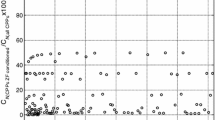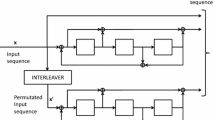Abstract
In this paper we consider cyclic shift interleavers for turbo coding. The properties of cyclic shift interleavers are discussed and compared with S-random interleavers. It is shown that the cyclic shift interleavers are equivalent or better than the S-random interleavers in the ability to break low weight input patterns. We estimated the performance of turbo codes with cyclic shift interleavers and compared it with the performance of S-random interleavers for varions interleaver sizes. The simulation results show that a turbo code with a cyclic shift interleaver can achieve a better performance than an S-random interleaver if the parameters of the cyclic shift interleaver are chosen properly. In addition, the cyclic interleavers have the advantages of lower design complexity and memory requirements.
Résumé
Dans cet article, on étudie les entrelacements à décalage cyclique pour le turbo-codage. Les propriétés de ces entrelacements sont décrites et comparées à celles des entrelacements de type S-random. Il est montré que les entrelacements à décalage cycliques sont équivalents voire meilleurs que les entrelacements S-random dans leur capacité à casser les mots d’entrée de poids faible. On a estimé les performance des turbocodes avec les entrelacements à décalage cyclique et on les a comparé avec les résultats des entrelacements S-random pour différentes tailles d’entrelacement. Les simulations montrent qu’un turbocode avec un entrelacement à décalage cyclique donne de meilleurs résultats à condition que les paramètres de cet entrelacement soient judicieusement choisis. Les entrelacements cycliques ont déplus, l’avantage d’une intégration peu complexe, et demandent peu de mémoire.
Similar content being viewed by others
References
Berrou (C.) andGlavieux (A.), “Near optimum error correcting coding and decoding: Turbo-codes,”Ieee Trans. Commun., vol. 44, n° 10, Oct. 1996, pp. 1261–1271.
Benedetto (S.) andMontorsi (G.), “Unveiling turbo-codes: Some results on parallel concatenated coding schemes,”Ieee Trans. Inform. Theory, vol. 42, n°2, Max. 1996, pp. 409–428.
Divsalax (D.) andF. Pollara (F.), “Turbo codes for PCS applications”; inProc. ICC’95, Seattle, WA, June 1995, pp. 54–59.
Barbulescu (A.S.) andPietrobon (S.S.), “Terminating the Trellis of Turbo Codes in the Same State,”Electronics Letters, vol. 31, pp. 22–23, 1995.
Richer (I.), “A Sample Interleaver for Use with Viterbi Decoding”,ieee Trans. Commun., COM-26, pp. 406–408, March 1978.
Yuan (J.), Vucetic (B.) andFeng (W.), “Combined turbo codes and interleaver design”,Ieee Trans. Commun., vol. 47, n° 4, Apr. 1999, pp. 484–487.
Vucetic (B.) andYuan (J.), “Turbo codes: principles and applications”, Kluwer Academic Publishers, 2000.
Feng (W.), Yuan (J.) andVucetic (B.), “A code matched interleaver design for turbo codes”, submitted toIeee Trans. Commun.
Ramsey (J.L.), “Realization of optimum interleavers”,Ieee Trans. Inform. Theory, vol. 16, n°3, May 1970, pp. 338–345.
Forney (G.D.), Jr., “Burst-correcting codes for the classic bursty channel”,Ieee Trans. Commun., vol. 19, n°5, Oct. 1971, pp. 772–781.
Hall (E.K.) andWilson (S.G.), “Convolutional interleavers for stream-oriented parallel concatenated convolutional codes”, inProc. 1998IEEE Int. Symposium on Inform. Theory, MIT, Cambridge, MA USA, Aug. 1998, p. 33.
Hokfelt (J.), Edfors (O.) and T. Msseng (T.), “A turbo code interleaver design criterion based on the performance of iterative decoding”,IEEE Communications Letters, vol. 5, n°2, Feb. 2001.
Takeshita (O.Y.) andCostello (D.J), Jr, “New Classes of Alge-braie Interleavers for Turbo Codes”,Proc. ISIT98, MA, USA, Aug. 1998, pp. 419.
Le Dantec (C.) andPiret (P.), “Algebraie and combinatorial methods producing good interleavers”,Proc. 2nd Inter. Symp. on Turbo Codes & Related Topics, Brest, France, Sep. 2000, pp. 271–274.
Crozier (S.), Guinand (P.), Lodge (J.) andHunt (A.), “Construction and Performance of New Tail-Biting Turbo Codes”, 6th International Workshop on Digital Signal Processing Techniques for Space Applications (DSP’98), Estec, Noordwijk, The Netherlands, Sept. 1998, paper 1.3.
Anderson (J.D.), “interleaver design for turbo coding”,Proc. Inter. Symp. on Turbo Codes and Related Topics, Brest, France, Sep. 1997, pp. 154–157.
Daneshgarah (F.) andMondin (M.), “Design of interleaver for turbo codes based on a cost function”,Proc. Inter. Symp. onTurbo Codes and Related Topics, Brest, France, Sep. 1997, pp. 255–258.
Author information
Authors and Affiliations
Corresponding authors
Rights and permissions
About this article
Cite this article
Yuan, J., Vucetic, B., Feng, W. et al. Design of cyclic shift interleavers for Turbo Codes. Ann. Télécommun. 56, 384–393 (2001). https://doi.org/10.1007/BF02995450
Received:
Accepted:
Issue Date:
DOI: https://doi.org/10.1007/BF02995450




